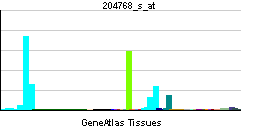Flap structure-specific endonuclease 1
| Flap structure-specific endonuclease 1 | |||||||||||||
|---|---|---|---|---|---|---|---|---|---|---|---|---|---|
 PDB rendering based on 1ul1. | |||||||||||||
| |||||||||||||
| Identifiers | |||||||||||||
| Symbols | FEN1 ; FEN-1; MF1; RAD2 | ||||||||||||
| External IDs | Template:OMIM5 Template:MGI HomoloGene: 3034 | ||||||||||||
| |||||||||||||
| RNA expression pattern | |||||||||||||
 | |||||||||||||
 | |||||||||||||
| More reference expression data | |||||||||||||
| Orthologs | |||||||||||||
| Template:GNF Ortholog box | |||||||||||||
| Species | Human | Mouse | |||||||||||
| Entrez | n/a | n/a | |||||||||||
| Ensembl | n/a | n/a | |||||||||||
| UniProt | n/a | n/a | |||||||||||
| RefSeq (mRNA) | n/a | n/a | |||||||||||
| RefSeq (protein) | n/a | n/a | |||||||||||
| Location (UCSC) | n/a | n/a | |||||||||||
| PubMed search | n/a | n/a | |||||||||||
Flap structure-specific endonuclease 1, also known as FEN1, is a human gene.[1]
The protein encoded by this gene removes 5' overhanging flaps in DNA repair and processes the 5' ends of Okazaki fragments in lagging strand DNA synthesis. Direct physical interaction between this protein and AP endonuclease 1 during long-patch base excision repair provides coordinated loading of the proteins onto the substrate, thus passing the substrate from one enzyme to another. The protein is a member of the XPG/RAD2 endonuclease family and is one of ten proteins essential for cell-free DNA replication. DNA secondary structure can inhibit flap processing at certain trinucleotide repeats in a length-dependent manner by concealing the 5' end of the flap that is necessary for both binding and cleavage by the protein encoded by this gene. Therefore, secondary structure can deter the protective function of this protein, leading to site-specific trinucleotide expansions.[1]
References
Further reading
- Kemeny MM, Alava G, Oliver JM (1993). "Improving responses in hepatomas with circadian-patterned hepatic artery infusions of recombinant interleukin-2". J. Immunother. 12 (4): 219–23. PMID 1477073.
- Li X, Li J, Harrington J; et al. (1995). "Lagging strand DNA synthesis at the eukaryotic replication fork involves binding and stimulation of FEN-1 by proliferating cell nuclear antigen". J. Biol. Chem. 270 (38): 22109–12. PMID 7673186.
- Hiraoka LR, Harrington JJ, Gerhard DS; et al. (1995). "Sequence of human FEN-1, a structure-specific endonuclease, and chromosomal localization of the gene (FEN1) in mouse and human". Genomics. 25 (1): 220–5. PMID 7774922.
- Robins P, Pappin DJ, Wood RD, Lindahl T (1994). "Structural and functional homology between mammalian DNase IV and the 5'-nuclease domain of Escherichia coli DNA polymerase I.". J. Biol. Chem. 269 (46): 28535–8. PMID 7961795.
- Murray JM, Tavassoli M, al-Harithy R; et al. (1994). "Structural and functional conservation of the human homolog of the Schizosaccharomyces pombe rad2 gene, which is required for chromosome segregation and recovery from DNA damage". Mol. Cell. Biol. 14 (7): 4878–88. PMID 8007985.
- Harrington JJ, Lieber MR (1994). "The characterization of a mammalian DNA structure-specific endonuclease". EMBO J. 13 (5): 1235–46. PMID 8131753.
- Shen B, Nolan JP, Sklar LA, Park MS (1996). "Essential amino acids for substrate binding and catalysis of human flap endonuclease 1". J. Biol. Chem. 271 (16): 9173–6. PMID 8621570.
- Chen U, Chen S, Saha P, Dutta A (1996). "p21Cip1/Waf1 disrupts the recruitment of human Fen1 by proliferating-cell nuclear antigen into the DNA replication complex". Proc. Natl. Acad. Sci. U.S.A. 93 (21): 11597–602. PMID 8876181.
- Warbrick E, Lane DP, Glover DM, Cox LS (1997). "Homologous regions of Fen1 and p21Cip1 compete for binding to the same site on PCNA: a potential mechanism to co-ordinate DNA replication and repair". Oncogene. 14 (19): 2313–21. doi:10.1038/sj.onc.1201072. PMID 9178907.
- Klungland A, Lindahl T (1997). "Second pathway for completion of human DNA base excision-repair: reconstitution with purified proteins and requirement for DNase IV (FEN1)". EMBO J. 16 (11): 3341–8. doi:10.1093/emboj/16.11.3341. PMID 9214649.
- Gary R, Ludwig DL, Cornelius HL; et al. (1997). "The DNA repair endonuclease XPG binds to proliferating cell nuclear antigen (PCNA) and shares sequence elements with the PCNA-binding regions of FEN-1 and cyclin-dependent kinase inhibitor p21". J. Biol. Chem. 272 (39): 24522–9. PMID 9305916.
- Stöhr H, Marquardt A, Rivera A; et al. (1998). "A gene map of the Best's vitelliform macular dystrophy region in chromosome 11q12-q13.1". Genome Res. 8 (1): 48–56. PMID 9445487.
- Jónsson ZO, Hindges R, Hübscher U (1998). "Regulation of DNA replication and repair proteins through interaction with the front side of proliferating cell nuclear antigen". EMBO J. 17 (8): 2412–25. doi:10.1093/emboj/17.8.2412. PMID 9545252.
- Warbrick E, Heatherington W, Lane DP, Glover DM (1998). "PCNA binding proteins in Drosophila melanogaster : the analysis of a conserved PCNA binding domain". Nucleic Acids Res. 26 (17): 3925–32. PMID 9705499.
- Hosfield DJ, Mol CD, Shen B, Tainer JA (1998). "Structure of the DNA repair and replication endonuclease and exonuclease FEN-1: coupling DNA and PCNA binding to FEN-1 activity". Cell. 95 (1): 135–46. PMID 9778254.
- Dianov GL, Jensen BR, Kenny MK, Bohr VA (1999). "Replication protein A stimulates proliferating cell nuclear antigen-dependent repair of abasic sites in DNA by human cell extracts". Biochemistry. 38 (34): 11021–5. doi:10.1021/bi9908890. PMID 10460157.
- Greene AL, Snipe JR, Gordenin DA, Resnick MA (1999). "Functional analysis of human FEN1 in Saccharomyces cerevisiae and its role in genome stability". Hum. Mol. Genet. 8 (12): 2263–73. PMID 10545607.
- Matsumoto Y, Kim K, Hurwitz J; et al. (1999). "Reconstitution of proliferating cell nuclear antigen-dependent repair of apurinic/apyrimidinic sites with purified human proteins". J. Biol. Chem. 274 (47): 33703–8. PMID 10559261.
- Spiro C, Pelletier R, Rolfsmeier ML; et al. (2000). "Inhibition of FEN-1 processing by DNA secondary structure at trinucleotide repeats". Mol. Cell. 4 (6): 1079–85. PMID 10635332.
- Hasan S, Stucki M, Hassa PO; et al. (2001). "Regulation of human flap endonuclease-1 activity by acetylation through the transcriptional coactivator p300". Mol. Cell. 7 (6): 1221–31. PMID 11430825.
| This protein-related article is a stub. You can help Wikipedia by expanding it. |